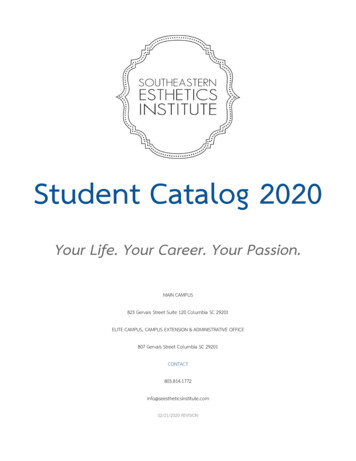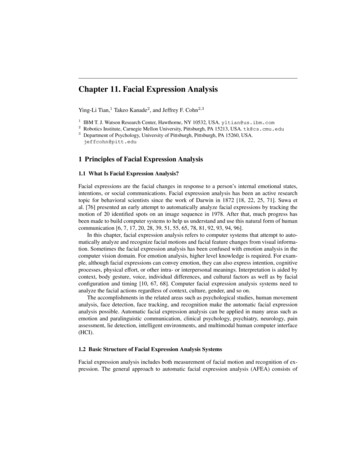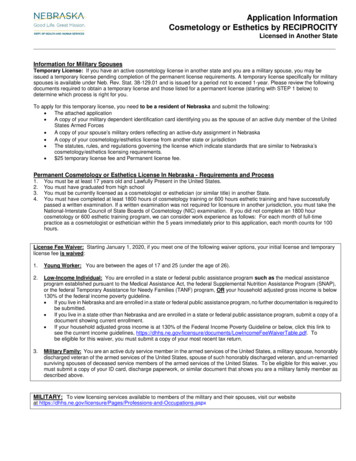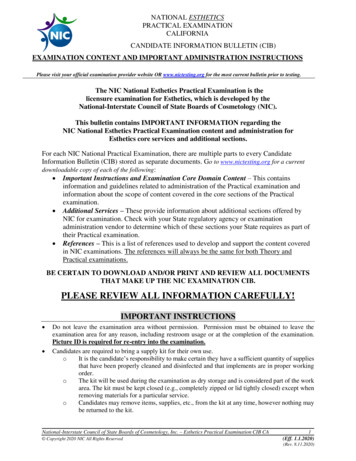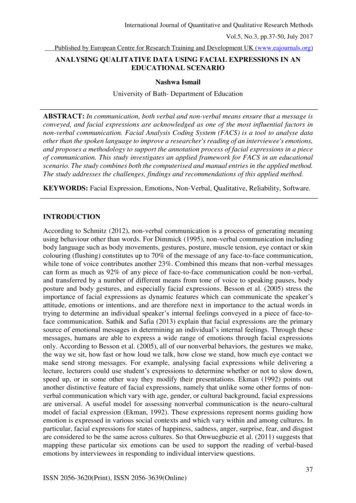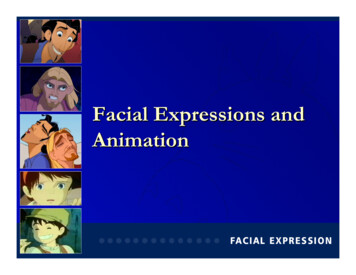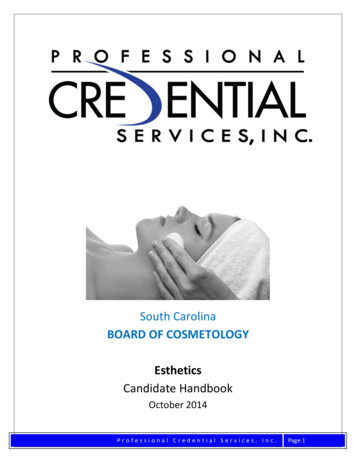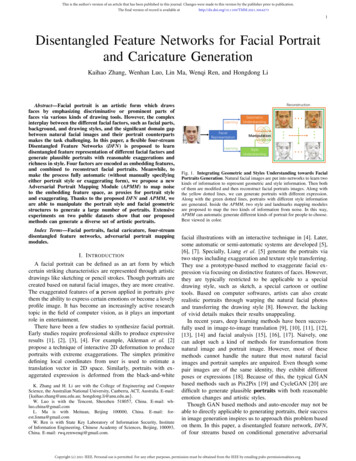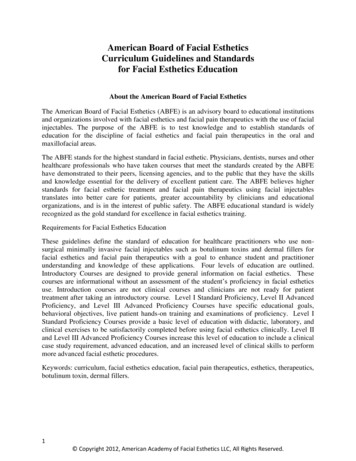
Transcription
American Board of Facial EstheticsCurriculum Guidelines and Standardsfor Facial Esthetics EducationAbout the American Board of Facial EstheticsThe American Board of Facial Esthetics (ABFE) is an advisory board to educational institutionsand organizations involved with facial esthetics and facial pain therapeutics with the use of facialinjectables. The purpose of the ABFE is to test knowledge and to establish standards ofeducation for the discipline of facial esthetics and facial pain therapeutics in the oral andmaxillofacial areas.The ABFE stands for the highest standard in facial esthetic. Physicians, dentists, nurses and otherhealthcare professionals who have taken courses that meet the standards created by the ABFEhave demonstrated to their peers, licensing agencies, and to the public that they have the skillsand knowledge essential for the delivery of excellent patient care. The ABFE believes higherstandards for facial esthetic treatment and facial pain therapeutics using facial injectablestranslates into better care for patients, greater accountability by clinicians and educationalorganizations, and is in the interest of public safety. The ABFE educational standard is widelyrecognized as the gold standard for excellence in facial esthetics training.Requirements for Facial Esthetics EducationThese guidelines define the standard of education for healthcare practitioners who use nonsurgical minimally invasive facial injectables such as botulinum toxins and dermal fillers forfacial esthetics and facial pain therapeutics with a goal to enhance student and practitionerunderstanding and knowledge of these applications. Four levels of education are outlined.Introductory Courses are designed to provide general information on facial esthetics. Thesecourses are informational without an assessment of the student’s proficiency in facial estheticsuse. Introduction courses are not clinical courses and clinicians are not ready for patienttreatment after taking an introductory course. Level I Standard Proficiency, Level II AdvancedProficiency, and Level III Advanced Proficiency Courses have specific educational goals,behavioral objectives, live patient hands-on training and examinations of proficiency. Level IStandard Proficiency Courses provide a basic level of education with didactic, laboratory, andclinical exercises to be satisfactorily completed before using facial esthetics clinically. Level IIand Level III Advanced Proficiency Courses increase this level of education to include a clinicalcase study requirement, advanced education, and an increased level of clinical skills to performmore advanced facial esthetic procedures.Keywords: curriculum, facial esthetics education, facial pain therapeutics, esthetics, therapeutics,botulinum toxin, dermal fillers.1 Copyright 2012, American Academy of Facial Esthetics LLC, All Rights Reserved.
1. STATEMENT OF PURPOSEThis document provides guidelines to assure safe and efficacious use of facial estheticspharmaceuticals and procedures for the health and welfare of the patient for esthetic andtherapeutic uses in the oral and maxillofacial areas. It establishes the standards of education inthe use of facial injectable pharmaceuticals and defines standards for the demonstration ofcompetency. It is intended to provide guidance to practitioners, educators and state boards toreassure the public on the issues of education, competency, and quality of care in the facialesthetics field. The curriculum outlined in this document is the standard of education for facialesthetics.2. INTRODUCTIONThe curriculum guidelines for facial esthetics education were developed through a consensusprocess with board members of the American Board of Facial Esthetics which is comprised ofrepresentatives from education organizations, academia, industry and private practice. Thepurpose of the American Board of Facial Esthetics is to provide the mechanism for thedevelopment and establishment of the standard of education for facial esthetics as provided bythe American Academy of Facial Esthetics.This document was developed using recommendations from a wide range of information thatexists on the use of facial esthetics. As a matter of course, these guidelines are circulated amongfacial esthetics educators, researchers, state boards, practitioners, and members of industry. Thisdocument is widely distributed and will be updated periodically. Questions or suggestions maybe addressed to the author of this document.Facial esthetics applications in have specific indications and contraindications for use intreatment. A working knowledge of basic, applied, and clinical science of facial estheticsprinciples, pharmaceuticals, and materials is essential for successful esthetic and therapeuticoutcomes.The manufacture, marketing, and distribution of facial esthetics pharmaceuticals are controlledthroughout the world by various regulatory agencies; e.g., in the United States the U.S. Food andDrug Administration, Health Canada and comparable regulatory agencies in other countries.These regulatory bodies control facial esthetics pharmaceuticals but do not regulate thehealthcare practitioner in the use of these devices. Facial esthetics does not yet comprise thebasis for a healthcare specialty, but it does require a level of education for their safe use toprovide the best esthetic and therapeutic outcomes and to promote patient safety.3. EDUCATIONAL STRUCTUREThe goal of these curriculum guidelines and standards of education is to enhance understandingand knowledge of the application of the principles related to best esthetic and therapeutic facialesthetics outcomes.There are four courses of facial esthetics education outlined in this document. An IntroductoryCourse offers general information but does not assess the enrollee’s proficiency and thereby does2 Copyright 2012, American Academy of Facial Esthetics LLC, All Rights Reserved.
not educate a practitioner to perform facial esthetics procedures. A Level I Standard ProficiencyCourse offers a level of education including instruction, live patient, mentored one-on-onehands-on exercises, and examination. This course must be satisfactorily completed beforeindependently performing facial esthetics procedures clinically. A Level II AdvancedProficiency Course offers a level of education including instruction, live patient, mentored oneon-one hands-on exercises, clinical case studies and examination on advanced facial estheticsprocedures. A Level III Advanced Proficiency Course offers instruction on very advancedprocedures that may only be accomplished with the previous stated education and sufficientpatient experience in advanced procedures. Any course on facial esthetics must be AGD PACE,ADA CERP, or medical CME certified for continuing education participation credit andapproved by the American Board of Facial Esthetics for credit towards accreditation.4. EDUCATIONAL PARAMETERSPractitioners must have training with demonstrated proficiency, knowledge and skill for facialesthetics procedures. Training must include specific objectives and requirements such as thosedescribed below, with demonstration of knowledge and clinical proficiency from certifiedtrainers. Competency evaluation should include both written and clinical examination.Evaluation of competency of practitioners must be assessed by trained and professional facialesthetics educators.Practitioner use of facial esthetics must be limited to those pharmaceuticals in which themanufacturer has met the regulatory requirements of the U.S. Food and Drug Administration forthose pharmaceuticals. Practitioners may use botulinum toxin and dermal filler pharmaceuticalsfor on-label and off-label uses which meet the reasonable standard of care in medicine.Clinicians should use these pharmaceuticals with a sound knowledge of indications andcontraindications and within the scope of medical practice based on competence as establishedby education, training and experience.Practitioners must have an intimate knowledge of basic facial esthetics principles, tissueinteraction, and specific facial esthetics safety requirements for the treatment area. They mustalso have knowledge of the pharmaceuticals, basic facial esthetics and biologic interactions. It isthe responsibility of the practitioner to follow the standard of education as defined by theseguidelines.3 Copyright 2012, American Academy of Facial Esthetics LLC, All Rights Reserved.
COURSE OUTLINESIntroductory Courses in Facial EstheticsThe course objective is to enable attendees to learn these practical concepts, techniques and newservices, and be familiar with the anatomy, materials, techniques, and instrumentation of facialinjectables such as botulinum toxin and dermal fillers in the oral and maxillofacial areas.An Introductory Course in Facial Esthetics must include these topics in the courses curriculum:Patient assessment and consultation for Botox and dermal fillersIndications and contraindications for extra-oral soft tissue estheticsSafety and risk issues for botulinum toxin/dermal fillers injectable therapyEnhancing and finishing esthetic cases with lip augmentations and cheek enhancementsManagement and treatment of possible complicationsPatient evaluation for best esthetic and therapeutic outcomesIntegrating botulinum toxin and dermal filler extra-oral soft tissue therapy into treatment plansIntroductory courses do not prepare a clinician in patient treatment and is informational only.Level I Standard Proficiency CourseThe curriculum for level I education in facial esthetics clinical procedures includes specificinstructions with demonstrated proficiency in didactic and live patient hands-on knowledge andtreatment. Live patient hands-on instruction includes demonstration and clinical treatment in theoral and maxillofacial areas on a model patient and must meet participation course guidelines.Practitioners must demonstrate competency in the safety aspects of facial estheticspharmaceuticals use prior to using these pharmaceuticals on patients. This is the level ofeducation that defines the standard of care. Auxiliaries are encouraged to demonstratecompetency in the safety aspects of facial esthetics pharmaceuticals use and in proper patienteducation for these procedures.Level I Standard Proficiency Courses must be a minimum of 16 hours in length with at least 8hours involving live patient treatment.A Level I Standard Proficiency Course must include these topics in the course curriculum:Patient Assessment and EvaluationPatient assessment and consultation for botulinum toxin and dermal fillers proceduresIndications and contraindications for these techniques and pharmaceuticalsMedical history taking as it relates to facial injectablesPatient evaluation for best facial esthetic and therapeutic outcomes4 Copyright 2012, American Academy of Facial Esthetics LLC, All Rights Reserved.
Anatomy of the Oral and Maxillofacial AreasIn depth education and hands-on training in the anatomy of the head, neck, and in depthanatomical instruction in the oral and maxillofacial structures including the neurophysiology,musculature and circulatory systemsNeurophysiology of the oral and maxillofacial areasPharmacology of oral and maxillofacial injectable treatmentTeach the best treatment techniques including anatomical muscle sites, muscle depths, properpreparation and dilution for the best oral and maxillofacial esthetic and therapeutic outcomesEstablishing proper lip and smile linesSafety and Risk IssuesProper sterile technique as it relates to the use of injectable pharmacologic agents and patienttreatmentSafety and risk issues for botulinum toxin and dermal fillers injectable therapyKnowledge of adverse reactions and how to avoid adverse reactionsManagement and treatment of adverse reactions including but not limited to four kinds of ptosis,vascular occlusion, and injection related complicationsFacial Esthetics Treatment Planning and DeliveryIntegrating botulinum toxin and dermal filler therapy into therapeutic and esthetic treatmentplansUnderstanding and incorporating oral and maxillofacial treatment into daily practiceBotulinium toxin therapeutic treatment of TMJ syndrome, facial pain and bruxism casesUpper and mid-face treatment procedures for therapeutic and esthetic outcomesFacial esthetic procedures in the oral and maxillofacial areas with facial injectables in associationwith reconstructive treatmentConservative lip enhancement procedures and how to avoid the most common pitfalls with lipenhancement proceduresEnhancing the natural lip anatomy to create esthetic lip structures and proper smile linesVolumizing the mid-face and lower face using anatomical landmarksPrecise delivery of facial injectablesSmoothing lip lines and eliminating radial lip linesLive patient hands-on training including diagnosis, treatment planning, and proper dosing anddelivery of botulinum toxin and dermal fillersRequired observation of live patient treatmentOne on one comprehensive mentored instructionCurrent research and future developments in maxillofacial esthetics pharmaceuticals andprocedures5 Copyright 2012, American Academy of Facial Esthetics LLC, All Rights Reserved.
The clinical live patient treatment and specific hands-on demonstration participation mustinclude:A.Facial esthetics instrument set-up and operation1.2.Delivery terilization standards and protocolFacial injectables operating parametersB.Infection control1.Identification and disposal of biological hazards2.Hazards and precautions3.Sterile techniquesC.Treatment objective and non-surgical techniques1.Indications and contraindications of facial esthetics use2.Alternate methods of treatment through differential diagnosis and offeringpatients all available options for oral and maxillofacial esthetics and therapeuticsD.E.F.Discussion of treatment sequence, patient management, postoperative instructionsAvoidance and management of complicationsSurgical and healing assessmentPractice ManagementProper fee structures for oral and maxillofacial injectable treatmentProvide customizable office forms and informed consent needed to begin treating patientsReview of state board lawsMalpractice and jurisprudence issuesEthics and oral and maxillofacial esthetics proceduresPractice organization and managementTeam training in facial estheticsPatient education in facial estheticsFinancial and insurance considerationsRecord keeping and reporting adverse eventsInformed consent procedures for facial esthetics treatmentCourse evaluation and certificate of attendance6 Copyright 2012, American Academy of Facial Esthetics LLC, All Rights Reserved.
Level II Advanced Proficiency CourseA level I course is a pre-requisite to participation in a level II Advanced Proficiency Course.Level II Advanced Proficiency Courses must be a minimum of 12 hours in length with at least 5hours involving live patient treatment.This level of education is elective and represents an advanced level of clinical competency insafety and clinical use of facial injectables in oral and maxillofacial esthetics and therapeutics.This level of education is intended for practitioners and includes assessment by writtenexamination, clinical proficiency, and clinical case presentation.A Level II Advanced Proficiency Course must include these topics in the course curriculum:Advanced education in oral and maxillofacial anatomy and facialinjectable pharmaceuticalsUpdate on the latest botulinum toxin pharmaceuticalsUsing advanced dermal filler hyaluronic acid and calciumhydroxylapetite pharmaceuticalsComprehensive patient assessment for combination botulinum toxinand dermal filler treatmentUnderstanding the precise anatomy demonstrating oral andmaxillofacial esthetic treatmentAdvanced hands-on anatomical instruction in the oral and maxillofacial areasThe precise skeletal and muscle anatomy involved in maxillary gingival excessDifferential diagnosis between facial injectable treatment and otherfacial treatment including but not limited to surgical and non-surgicalprocedures such as facelifts, lasers, IPL, and chemical peels.Understanding facial skin care to enhance treatment proceduresLevel II Advanced Facial Esthetics Treatment Planning and DeliveryAdvanced dermal filler injection techniques including cross hatching andscaffoldingAdvanced anatomical lip sculpting to create more precise lip and smile linesMid-face cheek enhancements and treating maxillary gingival excess(gummy smiles) as alternative treatment to surgical proceduresAdvanced upper and mid-facial procedures for esthetic and therapeutictreatmentUnderstanding and incorporating oral and maxillofacial treatment into dailypracticeTesting and treating hyperactive lower face muscles with botulinum toxinand dermal fillersIntroduction of treating the most common trigger points for facial pain therapyComprehensive treatment planning with facial injectables7 Copyright 2012, American Academy of Facial Esthetics LLC, All Rights Reserved.
The level II clinical live patient treatment and specific hands-on demonstration participationmust include:A.Review of facial esthetics instrument set-up and operation1.Delivery systema.Type Assemblyb.Inspectionc.Maintenanced.Sterilization standards and protocol2.Facial injectables operating parametersB.Review of infection control1.Identification and disposal of biological hazards2.Hazards and precautions3.Sterile techniquesC.D.E.F.Comprehensive treatment objective and non-surgical techniques1.Advanced indications and contraindications of facial esthetics andtherapeutics use3. Alternate methods of treatment through differential diagnosis and offering patients allavailable options for oral and maxillofacial esthetics and therapeuticsDiscussion of treatment sequence, patient management, postoperative instructionsAvoidance and management of complicationsSurgical and healing assessmentLevel II Advanced Practice ManagementPractice management techniques for creating a facial esthetic and therapeutic practice withinyour existing practiceMotivating patients to accept facial treatment plansBuilding your facial esthetic and therapeutic practice within your current practiceFee structures for comprehensive total facial treatmentEthical considerations in total facial estheticsPractice building internal marketing techniquesLevel III Advanced Proficiency CourseA level II course is a pre-requisite to participation in a level III Advanced Proficiency Course.Level III Advanced Proficiency Courses must be a minimum of 12 hours in length with at least 5hours involving live patient treatment.This level of education is elective and represents a more advanced level of clinical competencyin safety and clinical use of facial injectables and oral and maxillofacial esthetics. This level ofeducation is intended for healthcare practitioners and includes assessment by written8 Copyright 2012, American Academy of Facial Esthetics LLC, All Rights Reserved.
examination, clinical proficiency, and clinical case presentation. A level III advancedproficiency course may only be taken after the clinician demonstrates sufficient patientexperience with the standard and level II advanced procedures.A level III advanced proficiency course must include these topics in the course curriculum:Advanced education in oral and maxillofacial anatomy andfacial injectable pharmaceuticalsClinical update on the future of facial injectable pharmaceuticals andwhat will soon be availableComprehensive patient assessment for more advanced combinationtreatment with botulinum toxin and dermal filler pharmaceuticalsfor oral and maxillofacial esthetic and therapeutic casesKnowledge and ability to precisely treat over 30 muscles in the oraland maxillofacial region with botulinum toxinFacial skeletal anatomical considerationsLevel III Advanced Facial Esthetics Treatment Planning and DeliveryAdvanced dermal filler injection techniques including bulk filling andscaffoldingBotox therapeutic treatments for chronic migraine and facial pain –full FDA approved protocolCreating vector shaped soft tissue lip occlusionComprehensively treating the upper and lower face for oral and maxillofacialesthetics and therapeuticsCombining treatment of the mid-face and upper face with procedures to treatmultiple esthetic and therapeutic problemsCreating proper oral and maxillofacial contours with advanced lip sculpting,malar and sub-malar enhancements, and glabellar treatmentUnderstanding advanced facial esthetic skin treatmentsAdvanced trigger point therapy for facial pain casesPresentation of participant’s clinical casesThe level III clinical live patient treatment and specific hands-on demonstration participationmust include:A.Review of facial esthetics instrument set-up and operation1.Delivery systema.Type Assemblyb.Inspectionc.Maintenanced.Sterilization standards and protocol2.Facial injectables operating parameters9 Copyright 2012, American Academy of Facial Esthetics LLC, All Rights Reserved.
B.Review of infection control1.Identification and disposal of biological hazards2.Hazards and precautions3.Sterile techniquesC.Comprehensive treatment objective and non-surgical techniques1.Advanced indications and contraindications of facial esthetics and therapeuticsuse2.Alternate methods of treatment through differential diagnosis and offeringpatients all available options for oral and maxillofacial esthetics and therapeuticsD.E.F.Discussion of treatment sequence, patient management, postoperative instructionsAvoidance and management of complicationsSurgical and healing assessmentLevel III Advanced Practice ManagementAdvanced phone skill techniquesUsing social media to build your practiceCo-treatment planning with patientsMotivating patients to accept facial treatment plansUnderstanding and incorporating oral and maxillofacial treatmentinto your daily practiceFee structures for comprehensive total facial treatmentAdvanced practice building internal marketing techniquesWe hope you find these educational guidelines helpful and we welcome your feedback.For more information, please visit our website: /Inquiries, comments, suggestions and endorsements regarding this document should be directedto the author:Dr. Louis MalcmacherPresident, American Academy of Facial Esthetics4513 Churchill Blvd.University Heights, OH 44118800 952-0521drlouis@FacialEsthetics.org10 Copyright 2012, American Academy of Facial Esthetics LLC, All Rights Reserved.
American Board of Facial EstheticsAdvisory CouncilDr. Joseph A. BlaesDr. Tony FeckDr. Barry FreydbergDiana FriedmanDr. Lisa GermainDr. James JesseDr. Peter HarnoisDr. Jill LezaicTricia Osuna, RDH, BSDH, FAADHInquiries should be directed to the organizer:Kate PeakeAdministrator, American Board of Facial Esthetics4513 Churchill Blvd.University Heights, OH 44118800 952-0521kate@FacialEsthetics.org11 Copyright 2012, American Academy of Facial Esthetics LLC, All Rights Reserved.
provide the best esthetic and therapeutic outcomes and to promote patient safety. 3. EDUCATIONAL STRUCTURE The goal of these curriculum guidelines and standards of education is to enhance understanding and knowledge of the application of the principles related to best esthetic and therapeutic facial esthetics outcomes.

